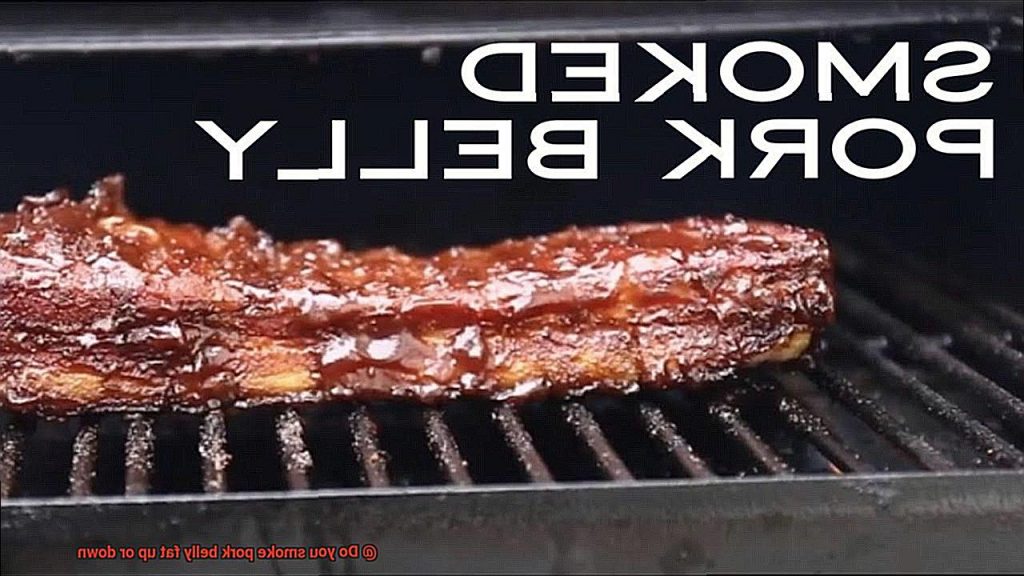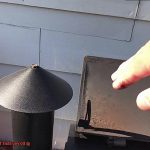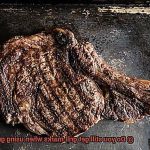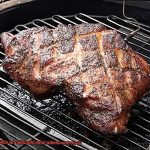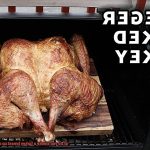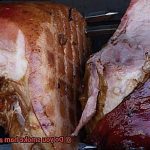Are you a die-hard pork belly fan, always on the lookout for ways to up your smoking game? Or maybe you’re just a curious cook who wants to know whether to smoke pork belly fat up or down. Whatever your reasons, we’ve got you covered with all the juicy details on this age-old debate.
Let’s start by acknowledging the undeniable importance of pork belly in the world of BBQ. This cut is a flavor powerhouse that can be smoked to perfection – but it’s also notoriously tricky to get right, especially when it comes to dealing with that pesky fat layer.
Some experts swear by smoking pork belly fat side up, arguing that this allows the fat to render down and infuse every inch of meat with succulent juiciness. Others say that flipping it over and smoking fat side down creates a crispy crust on top of the moist interior, delivering unbeatable texture and flavor.
So which method is best? We’ll explore both sides of the argument and give you our expert opinion on how to smoke your pork belly for maximum deliciousness. Get ready to take your BBQ skills to new heights.
Contents
What is Pork Belly?
This cut of meat comes from the underside of the pig and is known for its delicious flavor and versatility. Whether you’re a fan of bacon, pancetta, or pork belly burnt ends, pork belly is the perfect ingredient for creating these mouth-watering dishes.
One thing to keep in mind when working with pork belly is that it is made up of layers of meat and fat. In fact, the fat is the most prominent part of this cut, which can make it a bit tricky to smoke. However, when cooked properly, the fat can add an incredible amount of flavor and moisture to the meat.
When selecting pork belly for smoking, it’s important to choose a quality cut with plenty of marbling. This marbling will ensure that the meat stays moist and tender during the smoking process. Pork belly can be purchased bone-in or boneless and is typically sold in thick slices or as a whole slab.
Now, let’s talk about smoking pork belly. Many people prefer to smoke it with the fat side up. This allows the fat to slowly render down and baste the meat as it cooks. If you’re using a smoker with a water pan, this method can help regulate the temperature and add even more moisture to your pork belly.
On the other hand, some pitmasters prefer to smoke their pork belly with the fat side down. This method creates a crispy exterior on the meat by allowing the fat to render and crisp up against the heat source. If you’re someone who loves a crunchy texture on your meat, this might be the way to go.
Overall, whether you smoke your pork belly fat side up or down depends on your personal preference and equipment. It’s important to experiment with both methods to find what works best for you and your taste preferences.
Benefits of Smoking Pork Belly
Not only does smoking pork belly result in a mouth-watering flavor, but it also has several other benefits that make it worth trying.
Firstly, smoking pork belly is all about enhancing the flavor. The fat renders down during the smoking process, infusing the meat with a juicy and tender texture that cannot be achieved through other cooking methods. Plus, the smoky flavor adds an extra layer of complexity that will have your taste buds dancing with joy.
In addition to its fantastic taste, smoking pork belly can also help to preserve the meat. Through creating an environment hostile to bacteria, the smoking process extends the shelf life of the pork belly. This makes it a great option for those who want to prepare large quantities of meat or store it for later use.
But wait, there’s more. Smoking pork belly can also offer potential health benefits. As the fat melts away during smoking, it leaves behind a leaner cut of meat that still packs a flavorful punch. This is an excellent option for those who are looking for ways to reduce their fat intake without sacrificing taste.
So why not give it a try? Experiment with different smoking methods and find what works best for you. Whether you’re an experienced smoker or just starting out, smoked pork belly is a great way to enjoy this versatile cut of meat. In summary, some benefits of smoking pork belly include:
- Enhanced flavor
- Preservation
- Potential health benefits
The Debate: Smoking Pork Belly Fat Side Up or Down?
To smoke pork belly fat side up or down, that is the question on every pitmaster’s mind. The answer isn’t straightforward, as several factors come into play when deciding which method to use.
One of the most crucial factors is the type of smoker you’re using. Vertical smokers work best with fat side up smoking as it allows the rendered fat to drip down and baste the meat, creating a juicier end product. However, if you’re working with a horizontal smoker, smoking fat side down may be necessary to create a barrier between the meat and the heat source.
The quality of pork belly being used is another factor to consider. If you’ve got a high-quality cut with plenty of marbling, then smoking fat side up is likely your best option since the fat will render and baste the meat as it cooks. But if you’re working with a leaner cut of pork belly, then smoking fat side down may be necessary to prevent it from drying out.
But personal preference is also essential in making this decision. Ultimately, the decision of whether to smoke pork belly fat side up or down comes down to experimentation and finding what works best for your specific smoker and pork belly cut. So, don’t be afraid to try both methods and see which one produces the best results for you.
Pros and Cons of Smoking Pork Belly Fat Side Up
It all starts with deciding whether to smoke it fat side up or down. This is a highly debated topic among BBQ enthusiasts, but we’ve got you covered with the pros and cons of both methods.
Smoking pork belly fat side up has its advantages. The melting fat bastes the meat, keeping it moist and juicy throughout the smoking process. Additionally, the rendered fat creates a crispy, golden-brown crust on top of the meat, making for an impressive presentation. However, there are also potential downsides to consider.
One major disadvantage of smoking pork belly fat side up is that the fat can cause flare-ups and uneven cooking. The dripping fat can create sudden bursts of heat that scorch the meat and cause uneven cooking if not distributed evenly. Another downside is that it can hinder the development of a good bark on the meat, which is highly sought after by BBQ enthusiasts.
On the other hand, smoking pork belly fat side down can help prevent these issues. The fat acts as a protective layer between the heat source and meat, reducing flare-ups and ensuring even cooking. This method also makes it easier to develop a good bark on the meat since there’s no fat blocking its development. However, it can result in less juicy meat and a less visually appealing finished product.
Ultimately, whether you choose to smoke pork belly fat side up or down depends on your personal preference and experience. Experimenting with both methods can help you find what works best for you and your specific smoker setup. Keep in mind both the advantages and disadvantages before making a decision.
Pros and Cons of Smoking Pork Belly Fat Side Down
It’s a hotly contested topic, but fear not, because I’ve done the research and am here to guide you through the pros and cons of each technique.
Let’s start with the benefits of smoking pork belly fat side down. This method is favored by many because it helps to keep the meat moist and tender while it cooks. The layer of fat acts as a natural barrier between the meat and the heat source, preventing it from drying out. Plus, cooking fat side down creates a crispy crust that adds an irresistible texture to your finished product.
However, there are some potential drawbacks to consider. Smoking pork belly fat side down can hinder bark development, which is the flavorful crust on the outside of the meat. Additionally, if the heat source is too close to the meat, it can cause flare-ups and lead to uneven cooking.
On the other hand, smoking pork belly fat side up has its own set of advantages. One of the main benefits is that it allows for better rendering of the fat. As the fat slowly melts and bastes the meat, it creates a juicy and flavorful finished product that’s hard to resist. Furthermore, cooking fat side up can result in more even cooking as heat tends to rise from below rather than above.
Despite these benefits, there are also some potential downsides. Cooking pork belly fat side up can result in a greasier finished product if too much fat renders out during cooking. Additionally, it can still lead to uneven cooking if the heat source is too close to the meat.
Ultimately, choosing whether to cook your pork belly fat side up or down comes down to personal preference and experimentation. Try both methods and see which one works best for you and your setup. Just remember to closely monitor your cook and make any necessary adjustments along the way.
Factors to Consider When Deciding How to Smoke Your Pork Belly
But before you fire up your smoker, let’s explore the crucial factors to consider when deciding how to smoke your pork belly.
The first consideration is the fat content of your pork belly. If you have a leaner cut, smoking it fat side up can help keep the meat moist during the cooking process. The fat acts as a natural basting agent and helps to prevent dryness. However, if you have a fattier cut, smoking it fat side down can create a crispy exterior that is irresistible.
Another factor to consider is the type of smoker you are using. If you have a vertical smoker with a water pan, smoking your pork belly fat side up is recommended. The water pan will provide additional moisture and prevent the meat from drying out. On the other hand, if you are using a horizontal smoker without a water pan, smoking your pork belly fat side down may be better to avoid any flare-ups from dripping fat.
It’s essential to note that both methods have their potential drawbacks. Smoking fat side up can result in uneven cooking, while smoking fat side down may lead to dry meat if not monitored properly. Therefore, it’s essential to monitor the cooking process closely and make adjustments as necessary.
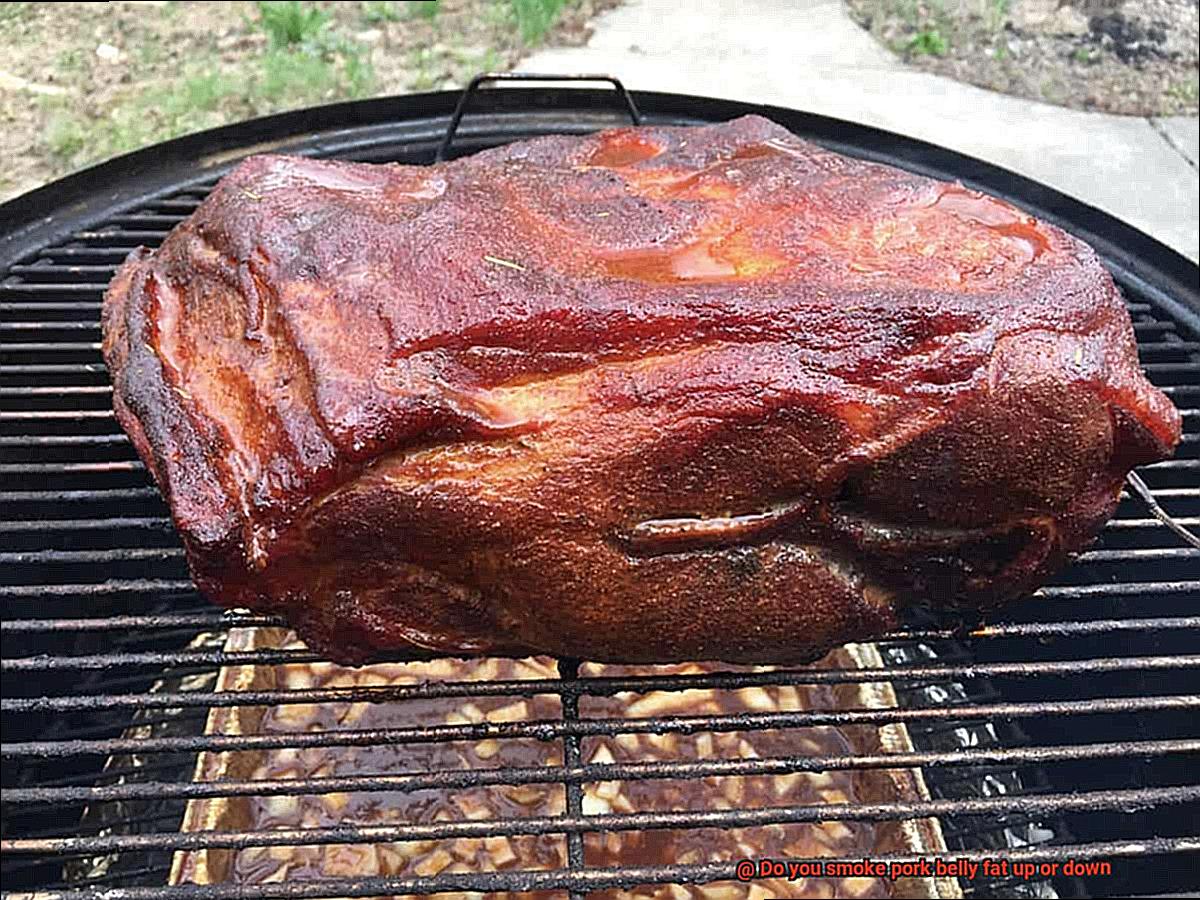
Now that we’ve covered the basics, let’s dive into some pro tips for smoking pork belly like a pro:
- Use a meat thermometer to ensure the internal temperature reaches 190-200°F for optimal tenderness.
- Consider adding wood chips or chunks for extra flavor. Hickory and applewood are popular choices for pork belly.
- Don’t forget to rest your meat before slicing. This allows the juices to redistribute and results in juicy, flavorful slices.
Tips for Smoking Pork Belly Successfully
Smoking pork belly can be a daunting task, but with the right tips and techniques, you can create a delicious and impressive dish that will have your guests begging for more. Here are five sub-sections with expanded tips for smoking pork belly successfully:
Choose the Right Wood
The type of wood you use for smoking plays a crucial role in the flavor of your pork belly. So, choose your wood wisely. Fruitwoods like cherry and apple are popular options as they impart a sweet, fruity flavor that pairs well with pork belly. On the other hand, hickory and oak woods add a smoky and intense flavor to the meat. Avoid using mesquite or other strong-flavored woods that can overpower the delicate flavor of the pork.
Brine the Pork Belly
Brining is an essential step in smoking pork belly as it helps to keep the meat moist and flavorful. A simple brine of water, salt, and sugar is all you need to get started. You can also add additional herbs and spices to the brine to enhance the flavor of your pork belly. Brining also helps to tenderize the meat, producing a succulent end product.
Season Generously
Seasoning your pork belly is an important step in creating a mouthwatering dish. Don’t be shy about it. Liberally rub your favorite spices or dry rub onto the meat, ensuring every inch is covered. The seasoning will enhance the flavor of the meat and create a delicious crust on the outside. Brown sugar, chili powder, garlic powder are some popular seasonings for pork belly.
Monitor the Temperature
Temperature control is crucial when smoking any meat, including pork belly. Maintain a temperature range between 225-250°F inside your smoker for optimal results. Use a meat thermometer to check that the internal temperature of the pork has reached 195°F for tender, juicy meat.
Overcooking can result in dry, tough meat, so be vigilant with temperature monitoring.
Rest Before Slicing
Resting your pork belly before slicing and serving allows the juices to redistribute throughout the meat, resulting in a moist and flavorful final product. Let the meat rest for at least 10-15 minutes after smoking before slicing. Slicing too soon can cause all those flavorful juices to escape, leaving you with dry meat.
u1grg8W_ZYs” >
Conclusion
As we wrap up our exploration of the age-old debate on whether to smoke pork belly fat side up or down, it’s clear that there’s no one-size-fits-all answer. Pitmasters have their preferences, but ultimately, personal taste reigns supreme.
Whether you opt for the fat side up method to infuse every inch of meat with succulent juiciness or choose the fat side down approach for a crispy crust atop moist interior, factors such as your smoker type and pork belly quality should be considered.
Smoking pork belly isn’t just about flavor enhancement. It also offers preservation benefits and potential health advantages. To achieve success in smoking this delicacy, remember to choose the right wood, brine your pork belly, season generously, monitor temperature closely, and allow it to rest before slicing.
So whether you’re a seasoned pro or a beginner in the world of BBQ smoking, experimenting with both methods is key to finding what works best for you and your smoker setup.

